+Search query
-Structure paper
| Title | Activation and closed-state inactivation mechanisms of the human voltage-gated K4 channel complexes. |
|---|---|
| Journal, issue, pages | Mol Cell, Vol. 82, Issue 13, Page 2427-22442.e4, Year 2022 |
| Publish date | Jul 7, 2022 |
 Authors Authors | Wenlei Ye / Hongtu Zhao / Yaxin Dai / Yingdi Wang / Yu-Hua Lo / Lily Yeh Jan / Chia-Hsueh Lee /  |
| PubMed Abstract | The voltage-gated ion channel activity depends on both activation (transition from the resting state to the open state) and inactivation. Inactivation is a self-restraint mechanism to limit ion ...The voltage-gated ion channel activity depends on both activation (transition from the resting state to the open state) and inactivation. Inactivation is a self-restraint mechanism to limit ion conduction and is as crucial to membrane excitability as activation. Inactivation can occur when the channel is open or closed. Although open-state inactivation is well understood, the molecular basis of closed-state inactivation has remained elusive. We report cryo-EM structures of human K4.2 channel complexes in inactivated, open, and closed states. Closed-state inactivation of K4 involves an unprecedented symmetry breakdown for pore closure by only two of the four S4-S5 linkers, distinct from known mechanisms of open-state inactivation. We further capture K4 in a putative resting state, revealing how voltage sensor movements control the pore. Moreover, our structures provide insights regarding channel modulation by KChIP2 and DPP6 auxiliary subunits. Our findings elucidate mechanisms of closed-state inactivation and voltage-dependent activation of the K4 channel. |
 External links External links |  Mol Cell / Mol Cell /  PubMed:35597238 / PubMed:35597238 /  PubMed Central PubMed Central |
| Methods | EM (single particle) |
| Resolution | 2.24 - 3.02 Å |
| Structure data | EMDB-26575, PDB-7uk5: EMDB-26576, PDB-7ukc: EMDB-26577, PDB-7ukd: EMDB-26578, PDB-7uke: EMDB-26579, PDB-7ukf: EMDB-26580, PDB-7ukg: EMDB-26581, PDB-7ukh: |
| Chemicals |  ChemComp-K:  ChemComp-HG:  ChemComp-ZN:  ChemComp-CA: |
| Source |
|
 Keywords Keywords | TRANSPORT PROTEIN / potassium channel complex / MEMBRANE PROTEIN |
 Movie
Movie Controller
Controller Structure viewers
Structure viewers About Yorodumi Papers
About Yorodumi Papers




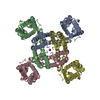

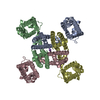

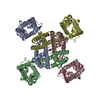

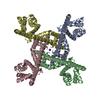

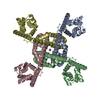

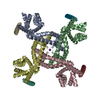


 homo sapiens (human)
homo sapiens (human)